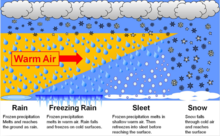

In meteorology, the different types of precipitation often include the character, formation, or phase of the precipitation which is falling to ground level. There are three distinct ways that precipitation can occur. Convective precipitation is generally more intense, and of shorter duration, than stratiform precipitation. Orographic precipitation occurs when moist air is forced upwards over rising terrain and condenses on the slope, such as a mountain.
Precipitation can fall in either liquid or solid phases, is mixed with both, or transition between them at the freezing level. Liquid forms of precipitation include rain and drizzle and dew. Rain or drizzle which freezes on contact with a surface within a subfreezing air mass gains the preceding adjective "freezing", becoming the known freezing rain or freezing drizzle. Slush is a mixture of both liquid and solid precipitation. Frozen forms of precipitation include snow, ice crystals, ice pellets (sleet), hail, and graupel. Their respective intensities are classified either by rate of precipitation, or by visibility restriction.